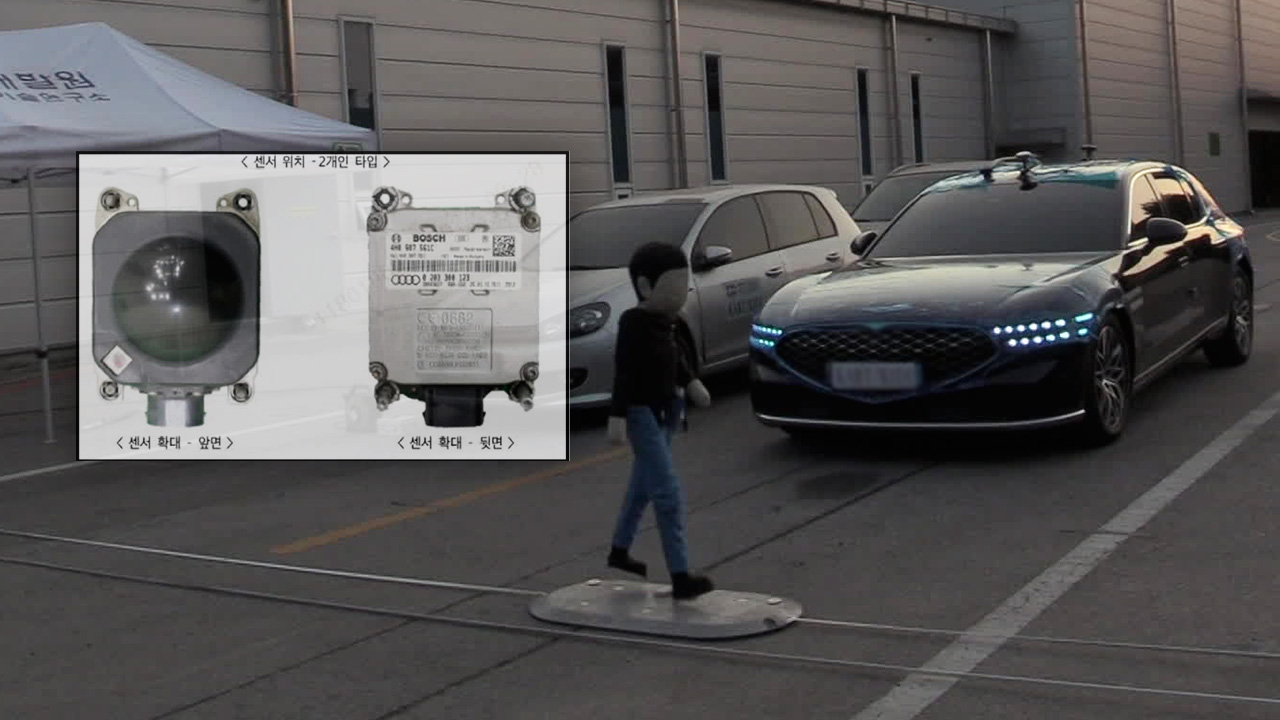AEBS performance in vehicles to prevent pedestrian accidents varies by vehicle, calls for government support towards installation costs
입력 2024.11.11 (00:09)
읽어주기 기능은 크롬기반의
브라우저에서만 사용하실 수 있습니다.
[Anchor]
To prevent pedestrian accidents, the installation of emergency automatic control devices has been mandatory for all new cars since last year.
However, the performance of these devices varies by vehicle type, and 7 out of 10 passenger cars still do not have them installed, highlighting the need for standards and support measures.
Reporter Kim Hye-joo has the story.
[Report]
A person suddenly jumps out, and the vehicle cannot avoid hitting them.
A vehicle making a left turn hits a pedestrian.
To prevent such accidents, the Automatic Emergency Braking System (AEBS), which automatically stops the vehicle when it detects pedestrians on the road, has been mandatory since last year.
Vehicles equipped with this device have been analyzed to have over a 30% lower occurrence of fatal accidents compared to those without it.
However, it has been found that the effectiveness of preventing pedestrian accidents varies depending on the performance of the device.
In fact, 36 out of 45 vehicle types equipped with devices that can detect pedestrians not only in the front and rear but also during left and right turns were able to avoid collisions.
In contrast, only 23 vehicle types with only the front and rear pedestrian detection capabilities avoided collisions.
As the performance of AEBS improves, it can avoid a wider variety of accidents, but the capabilities differ from vehicle to vehicle.
[Kim Kwan-hee/Head of Testing Research Team, Korea Insurance Development Institute: "There are actually no standards for under what conditions and to what extent pedestrians should be detected and accidents prevented."]
Due to cost issues, the proportion of passenger cars without AEBS remains at 74%.
[Lee Ho-geun/Professor, Department of Future Automotive Engineering, Daedeok University: "If the government can reduce social indirect costs and burdens, a system to support part of the installation costs is necessary...."]
However, experts emphasize that AEBS is an auxiliary device for accident prevention, and defensive driving, such as maintaining a safe distance, should take priority.
This is KBS News, Kim Hye-joo.
To prevent pedestrian accidents, the installation of emergency automatic control devices has been mandatory for all new cars since last year.
However, the performance of these devices varies by vehicle type, and 7 out of 10 passenger cars still do not have them installed, highlighting the need for standards and support measures.
Reporter Kim Hye-joo has the story.
[Report]
A person suddenly jumps out, and the vehicle cannot avoid hitting them.
A vehicle making a left turn hits a pedestrian.
To prevent such accidents, the Automatic Emergency Braking System (AEBS), which automatically stops the vehicle when it detects pedestrians on the road, has been mandatory since last year.
Vehicles equipped with this device have been analyzed to have over a 30% lower occurrence of fatal accidents compared to those without it.
However, it has been found that the effectiveness of preventing pedestrian accidents varies depending on the performance of the device.
In fact, 36 out of 45 vehicle types equipped with devices that can detect pedestrians not only in the front and rear but also during left and right turns were able to avoid collisions.
In contrast, only 23 vehicle types with only the front and rear pedestrian detection capabilities avoided collisions.
As the performance of AEBS improves, it can avoid a wider variety of accidents, but the capabilities differ from vehicle to vehicle.
[Kim Kwan-hee/Head of Testing Research Team, Korea Insurance Development Institute: "There are actually no standards for under what conditions and to what extent pedestrians should be detected and accidents prevented."]
Due to cost issues, the proportion of passenger cars without AEBS remains at 74%.
[Lee Ho-geun/Professor, Department of Future Automotive Engineering, Daedeok University: "If the government can reduce social indirect costs and burdens, a system to support part of the installation costs is necessary...."]
However, experts emphasize that AEBS is an auxiliary device for accident prevention, and defensive driving, such as maintaining a safe distance, should take priority.
This is KBS News, Kim Hye-joo.
■ 제보하기
▷ 카카오톡 : 'KBS제보' 검색, 채널 추가
▷ 전화 : 02-781-1234, 4444
▷ 이메일 : kbs1234@kbs.co.kr
▷ 유튜브, 네이버, 카카오에서도 KBS뉴스를 구독해주세요!
- AEBS performance in vehicles to prevent pedestrian accidents varies by vehicle, calls for government support towards installation costs
-
- 입력 2024-11-11 00:09:44

[Anchor]
To prevent pedestrian accidents, the installation of emergency automatic control devices has been mandatory for all new cars since last year.
However, the performance of these devices varies by vehicle type, and 7 out of 10 passenger cars still do not have them installed, highlighting the need for standards and support measures.
Reporter Kim Hye-joo has the story.
[Report]
A person suddenly jumps out, and the vehicle cannot avoid hitting them.
A vehicle making a left turn hits a pedestrian.
To prevent such accidents, the Automatic Emergency Braking System (AEBS), which automatically stops the vehicle when it detects pedestrians on the road, has been mandatory since last year.
Vehicles equipped with this device have been analyzed to have over a 30% lower occurrence of fatal accidents compared to those without it.
However, it has been found that the effectiveness of preventing pedestrian accidents varies depending on the performance of the device.
In fact, 36 out of 45 vehicle types equipped with devices that can detect pedestrians not only in the front and rear but also during left and right turns were able to avoid collisions.
In contrast, only 23 vehicle types with only the front and rear pedestrian detection capabilities avoided collisions.
As the performance of AEBS improves, it can avoid a wider variety of accidents, but the capabilities differ from vehicle to vehicle.
[Kim Kwan-hee/Head of Testing Research Team, Korea Insurance Development Institute: "There are actually no standards for under what conditions and to what extent pedestrians should be detected and accidents prevented."]
Due to cost issues, the proportion of passenger cars without AEBS remains at 74%.
[Lee Ho-geun/Professor, Department of Future Automotive Engineering, Daedeok University: "If the government can reduce social indirect costs and burdens, a system to support part of the installation costs is necessary...."]
However, experts emphasize that AEBS is an auxiliary device for accident prevention, and defensive driving, such as maintaining a safe distance, should take priority.
This is KBS News, Kim Hye-joo.
To prevent pedestrian accidents, the installation of emergency automatic control devices has been mandatory for all new cars since last year.
However, the performance of these devices varies by vehicle type, and 7 out of 10 passenger cars still do not have them installed, highlighting the need for standards and support measures.
Reporter Kim Hye-joo has the story.
[Report]
A person suddenly jumps out, and the vehicle cannot avoid hitting them.
A vehicle making a left turn hits a pedestrian.
To prevent such accidents, the Automatic Emergency Braking System (AEBS), which automatically stops the vehicle when it detects pedestrians on the road, has been mandatory since last year.
Vehicles equipped with this device have been analyzed to have over a 30% lower occurrence of fatal accidents compared to those without it.
However, it has been found that the effectiveness of preventing pedestrian accidents varies depending on the performance of the device.
In fact, 36 out of 45 vehicle types equipped with devices that can detect pedestrians not only in the front and rear but also during left and right turns were able to avoid collisions.
In contrast, only 23 vehicle types with only the front and rear pedestrian detection capabilities avoided collisions.
As the performance of AEBS improves, it can avoid a wider variety of accidents, but the capabilities differ from vehicle to vehicle.
[Kim Kwan-hee/Head of Testing Research Team, Korea Insurance Development Institute: "There are actually no standards for under what conditions and to what extent pedestrians should be detected and accidents prevented."]
Due to cost issues, the proportion of passenger cars without AEBS remains at 74%.
[Lee Ho-geun/Professor, Department of Future Automotive Engineering, Daedeok University: "If the government can reduce social indirect costs and burdens, a system to support part of the installation costs is necessary...."]
However, experts emphasize that AEBS is an auxiliary device for accident prevention, and defensive driving, such as maintaining a safe distance, should take priority.
This is KBS News, Kim Hye-joo.
-
-

김혜주 기자 khj@kbs.co.kr
김혜주 기자의 기사 모음
-
이 기사가 좋으셨다면
-
좋아요
0
-
응원해요
0
-
후속 원해요
0













![[단독] 대통령실 국정상황실 파견 총경급 인사 문책성 복귀](/data/layer/904/2025/07/20250707_q2dg0Q.jpg)

이 기사에 대한 의견을 남겨주세요.